Posted by Anita on 05.21.11 11:06 AM
 Rhubarb when raw is so tough
Rhubarb when raw is so tough
And its leaves contain poisonous stuff,
– But when cleaned and de-soiled
– Dipped in sugar and boiled
Then the stalks are quite tasty enough.
– — The Rhubarb Compendium
—-
This month’s CanJam challenge — hosted by Toronto Tasting Notes — offers not one but two options for us to put up: Asparagus or rhubarb. Given that I’d used the former in last month’s project (the theme was herbs, and I made tarragon asparagus pickles), my path was clear.
I know that some of my friends (including both of the people who I consider my pie gurus) will disown me when I admit this, but I’m not generally a fan of rhubarb’s texture; I just can’t tolerate the usual sliminess. I love its tart fruitiness, so I’ve learned a trick or two for keeping it firm in desserts, but canning it in a water bath — the whole point of the CanJam — would undo all of those careful preparations.
But there are a few preserves, like flavored syrups, where the pulp of the fruit (or vegetable, in this case) is strained out, leaving just the juice and its flavor behind. Best of all, syrups are simple to preserve, and they’re a compact way to save the flavors of seasonal produce for enjoyment throughout the year. You can also freeze syrups, if — unlike me — you’ve got the space to safely stash a glass bottle.
You can use this flavored syrup any place a sweet-spicy-sour touch would be welcome, something as simple as brushing it onto a cake, or diluting it with sparkling water for a homemade soda. To my mind, its perfect use is making a pink variation on the venerable summer drink known as the Paloma (or even a virgin variation, sans tequila).



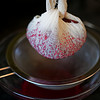
Rhubarb-Ginger Syrup
– makes 1 jar to keep, plus a little to use right away; can easily be doubled or tripled
1.5 cups white sugar
1 cup water
2 cups thick-sliced rhubarb stalks, leaves discarded
1 cup chopped ginger (no need to peel)
Prepare canner (or a saucepan deep enough to cover the jar by 3 inches), plus a small jam jar and its lid, according to the usual method; keep jar and lid hot until needed.
In a medium saucepan, bring the sugar and water to a simmer, stirring to dissolve. Add the rhubarb and ginger; return to a simmer, then reduce heat and let slowly bubble until the rhubarb is thoroughly soft. Remove from heat and let steep for 30 minutes. Meanwhile, line a metal strainer with cheesecloth, and place it over a heatproof bowl. (If you want crystal-clear syrup, use a muslin jelly bag and be prepared to wait for gravity to draw the liquid into the bowl; be careful not to press or squeeze the solids.)
Bring the strained syrup back to a simmer, then pour into the heated jar, leaving 1/2-inch headspace. Wipe rim and center lid on jar. Screw band to fingertip-tight.
Place jar in canner. Bring to a boil; process covered for 5 minutes. Remove lid, wait 5 minutes, then remove jar. Cool, check seal, and store in a cool, dark place.
—-
 La Paloma Rosada
La Paloma Rosada
1.5 to 2oz blanco tequila
1/2 oz rhubarb-ginger syrup
grapefruit bitters
tart grapefruit soda (such as Izze Grapefruit)
Fill a Collins glass with ice. Add the tequila and syrup; fill with grapefruit soda, and give a good stir. Top the ice with a few shakes of bitters.
CanJam, drinks, preserving & infusing, recipes
13 Comments »




Posted by Anita on 12.19.10 3:24 PM
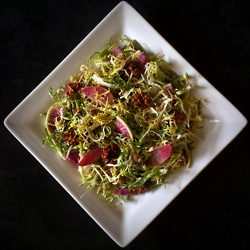 Hungry Mother always seemed like the kind of place we’d enjoy: local and sustainable sourcing, Southern-inspired food, and a great cocktail list. It’s been on our short list of places to try for years, and on a recent trip to Boston, we finally made it there.
Hungry Mother always seemed like the kind of place we’d enjoy: local and sustainable sourcing, Southern-inspired food, and a great cocktail list. It’s been on our short list of places to try for years, and on a recent trip to Boston, we finally made it there.
It’s easy to win hearts and minds with menu items like pimento cheese, bourbon-braised pork shoulder, and cheddar grits with house-made tasso, not to mention winning cocktails like the No. 43 (rye, tawny port, maple syrup, and bitters). But amid all of these decadent treats was a salad that sounded so tame that I actually felt a little boring for ordering it.
The buttermilk-chive dressing was what pushed me over the edge, luring me away from other options. That, I suppose, and the pecans, which I love but can’t get locally here in Northern California. What I hadn’t expected was that the farro — a humble, wheat-like grain — would be the star of the show, bringing a nutty depth to the dish that made it substantial enough to stand up to the rich main courses that followed.
I woke up the next morning dreaming about this salad, knowing I wanted to recreate it when we got home. I realized that with a few adjustments — walnuts for pecans, wheatberries for farro — I could make it entirely from locally sourced ingredients, making it a perfect candidate for our first Dark Days Eat Local Challenge meal of the winter.
Don’t be put off by the little ingredient-prep recipes that go into this dish; none are particularly difficult or time-consuming, and all of the parts can be stored for future use. And be sure that you’re picking through and using tender frisée leaves, as more-mature ones are unpleasantly grassy and spiky.



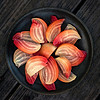
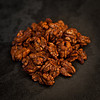
Autumn Salad with Wheatberries
– inspired by Hungry Mother; serves 2
6 cups loosely packed tender frisée leaves
3 to 4T buttermilk dressing
1/2 cup cooked wheatberries
roasted beet wedges equal to 1 large beet (or 2 to 3 small beets)
1 watermelon radish (or 3 to 5 small radishes), sliced thinly and cut into quarter-rounds
6 to 8 sweet-savory walnut halves
Toss all ingredients together, and serve on chilled shallow bowls or rimmed plates.
– Roasted Beets
Preheat the oven to 375°F. Scrub the beets and trim off tops and tails. Place in a baking dish about as deep as the beets are tall, and add 1/4 inch of water. Cover tightly with foil and bake until the beets are barely tender through (run a toothpick or cake tester through the center), about 45 minutes for large beets, 20 to 30 minutes for smaller ones. Remove from the oven and let sit, covered, for 5 more minutes. Uncover the beets, rub off the skin, and trim the tops and tails again. Cut into wedges and season to taste with salt. If not using within an hour or so, toss with a bit of olive oil; they will keep a few days in the fridge if well covered.
– Cooked Wheatberries
Note: For the 1/2 cup cooked wheatberries the salad requires, you’ll need 1/4 cup uncooked. However, it’s hard to cook less than 1 cup at a time. Leftovers freeze well, and they make a great base for grain salads, or in place of cooked rice in soups.
Soak the wheatberries overnight, or for at least a few hours. Bring the berries to a boil in a large saucepan of salted water. Reduce heat to a slow simmer and cook until tender but not blown out, about 2 hours. (Depending on freshness, wheat variety, and soaking time, this can take as little as 45 minutes or up to 3 hours.) When cooked, drain the berries and set aside.
– Buttermilk-Green Garlic Dressing
1/4 cup sour cream or plain yogurt
1/4 cup buttermilk
1/4 cup mayonnaise
1 tsp Champagne vinegar (or white-wine vinegar)
1 stalk green garlic, minced, or 1T minced chives
coarse-ground black pepper, to taste
salt, to taste
Mix all ingredients in a bowl, and refrigerate for at least an hour.
– Sweet-Savory Walnuts or Pecans
adapted from Epicurious
2 tsp sugar
1/4 tsp salt
1/4 tsp paprika
1T egg white
1 cup walnut or pecan halves (about 1/4 pound)
Preheat oven to 350°F. Lightly oil a rimmed cookie sheet, or line it with parchment.
Whisk together sugar, salt, and paprika in a small bowl. Whisk egg white in a medium bowl until frothy, then stir in nuts, mixing until evenly coated with egg white. Add sugar mixture and toss to coat.
Spread the nuts in the pan in a single layer. Bake, stirring once or twice, until dry and well toasted, about 20 minutes. Loosen nuts from pan, then cool completely.
Farmers and food artisans who created the ingredients for this week’s meal:
Massa Organics, Hamilton City: wheatberries
Star Route, Bolinas: frisée
Mariquita Farm, Watsonville: beets, watermelon radish
Glashoff, Fairfield: walnuts
Clover Organic, Petaluma: buttermilk, yogurt
Eatwell Farm, Dixon: Pastured eggs (for mayo)
Bariani, Sacramento: olive oil
Katz, Napa: Champagne vinegar
Knoll Farms, Brentwood: green garlic
Guisto’s Vita-Grain, South San Francisco: sea salt
Range Brothers, Capay Valley: pork chop
Exemptions: sugar, peppercorns
Boston, Dark Days challenge, locavore, recipes
13 Comments »




Posted by Anita on 12.10.10 1:48 PM
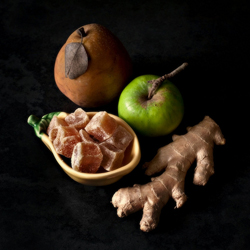 This month’s final CanJam theme — dried fruit — had me kicking the walls. I don’t really enjoy the texture of dried fruit, and given that it’s already preserved, it seems redundant to can it.
This month’s final CanJam theme — dried fruit — had me kicking the walls. I don’t really enjoy the texture of dried fruit, and given that it’s already preserved, it seems redundant to can it.
But our hostess, Tigress, set naysayers’ minds at easy, allowing that even a small amount of the featured ingredient was acceptable. With that in mind, I went back through the files to find a way to preserve a seasonal fresh ingredient with just a touch of dried-fruit flavor.
While looking through recipes for last month’s pome-fest, my runner-up candidate sounded so good that I put it aside, knowing I’d want to make it some other time. Calling for both dried currants and candied ginger, it definitely fits the bill for this month’s CanJam.
If you, like me, can’t get enough of ginger’s piquant flair, you’ll be happy to see that this recipe calls for ginger in three forms — fresh, candied, and ground — for a triple dose of sweet heat. The original recipe-writer calls this preserve a chutney, which it technically is, given the onions and vinegar. But the resulting texture is more like a savory compote or chunky pear-applesauce hybrid than the sticky, almost-chewy texture most of us associate with chutney. It’s delicious, of course (just look at that ingredients list… how could it not be?), but I felt a name-change was in order.
If your pears are thin-skinned and relatively free of blemishes, you may want to leave them unpeeled, to give the preserve a more rustic texture and color. If you prefer a smoother, lighter-colored preserve, do peel them. Note too that I’ve halved the original recipe’s quantities, so doubling the quantities below to make a 6-jar batch should be trouble-free.




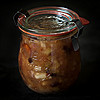
Savory Triple-Ginger Pear Preserves
– adapted from Chow Times
3 cups peeled (if desired), cored, and diced pears, mixed varieties
1/2 cup peeled, cored, and diced tart apple
1/2 cup chopped onion
1/4 cup minced candied ginger
1/4 cup seedless sultanas or dried currants
5oz apple cider vinegar
1/2 cup raw sugar or light brown sugar
1 clove garlic, sliced
1/2 T grated fresh ginger
1/4 tsp salt
1/4 tsp red pepper flakes
1/4 tsp ground dried ginger
Prepare canner, lids, and three 8-oz jars according to the usual method; keep jars hot until needed.
In a medium saucepan, heat all ingredients except pears, and bring to a boil over medium-high heat. Reduce heat to medium-low and simmer uncovered for 30 minutes, stirring occasionally.
Add the pears and bring to a boil over medium-high heat. Reduce heat again to medium-low and simmer until the desired consistency is reached, about 30 minutes depending on simmering speed, stirring occasionally at first but more often as you come closer to the end. The mixture is ready when it easily holds together and no excess liquid appears when parted with a spoon.
Using a stainless-steel canning funnel, ladle preserves into hot jars, leaving 1/2-inch headspace. Remove air bubbles using a plastic knife or chopstick, and readjust headspace as needed. Wipe jar rims with a clean, damp cloth and center the hot lids on jars. Screw band to fingertip-tight.
Place jars in canner, ensuring they are completely submerged. Bring to a boil and process covered for 10 minutes. Remove canner lid; wait 5 minutes, then remove jars. Cool thoroughly, check for seals, and store in a cool, dark place for up to a year.
CanJam, locavore, preserving & infusing, recipes
6 Comments »




Posted by Anita on 11.19.10 12:41 PM
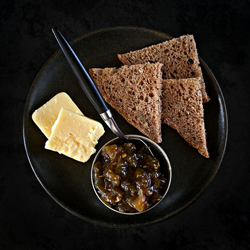 The Cosmic Cowgirl picked pomes — that’s apples, pears, and quinces to you and me — as the theme of this month’s CanJam. As I dreamed of making mebrillo, pear butter, and dozens of other suitable recipes, I sat at the window overlooking our garden, still groaning with tomatoes. They’re ripening slowly now, and it’s time to plant our winter crops; a green tomato preserve was what I really needed to tackle before I gave any thought to recreational canning.
The Cosmic Cowgirl picked pomes — that’s apples, pears, and quinces to you and me — as the theme of this month’s CanJam. As I dreamed of making mebrillo, pear butter, and dozens of other suitable recipes, I sat at the window overlooking our garden, still groaning with tomatoes. They’re ripening slowly now, and it’s time to plant our winter crops; a green tomato preserve was what I really needed to tackle before I gave any thought to recreational canning.
As interesting as it seemed, we never made much of a dent in the green tomato jam I made around this time last year. It’s finally dawning on me that our capacity for sweet preserves is fairly limited, so I knew this year’s project would have to be savory. I hit the books, and came up with a few ideas for pickles and such, but nothing that really made me want to pull out the canner. Then, while browsing on a completely unrelated topic, I serendipitously encountered a recipe for a green tomato and apple chutney. Voilá — two birds, one stone.
I love a nice, tidy solution, but experience has taught me that my effort’s wasted if I preserve something nobody wants to eat. That won’t be a problem this year: Barely an hour after the lids went ‘ping!’, we’d already polished off one small jar of this piquant preserve, slathered on good brown bread with hunks of aged cheddar to make a thoroughly autumnal ploughman’s lunch. A few days later, we cracked another jar and gobbled up a good share of it alongside an Indian curry. And just last night, Cameron sighed as he wondered aloud how well it would go alongside the Thanksgiving turkey, in place of the cranberry sauce that neither of us really craves.
I find myself in the odd position of hoping that the weather turns cold soon, so that the last of this year’s tomatoes won’t ripen and I’ll have another batch of green fruit to transform into chutney. If not, at least I know what I’ll be doing with the tail end of next year’s crop.
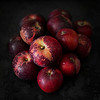
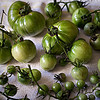

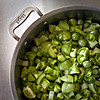
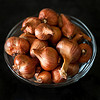
English-style Spicy Green Tomato & Apple Chutney
– adapted from BBC Food
1/2 oz fresh ginger (about a 2-inch piece)
8 to 10 fresh hot chiles, halved but not seeded
4 pounds green tomatoes, chopped
1 pound apples, peeled, cored, and chopped
4 oz golden raisins, chopped, or dried currants (or half of each)
1 pound shallots, chopped
2 tsp kosher salt
1 pound raw sugar or light brown sugar
1 pint malt vinegar
Prepare canner, lids, and nine 8-oz jars according to the usual method; keep jars hot until needed.
Bruise the ginger and tie it into a muslin jelly bag with the chiles.
Place jelly bag and the remaining ingredients in a Dutch oven or other large, wide pan. Bring to a boil, stirring until the sugar has dissolved, and simmer until the desired consistency is reached, about an hour depending on simmering speed, stirring occasionally at first but more often as you come closer to the end.
Remove the jelly bag. Using a stainless-steel canning funnel, ladle the chutney into hot jars, leaving 1/2-inch headspace. Remove air bubbles using a plastic knife or chopstick, and readjust headspace as needed. Wipe jar rims with a clean, damp cloth and center the hot lids on jars. Screw band to fingertip-tight.
Place jars in canner, ensuring they are completely submerged. Bring to a boil and process covered for 15 minutes. Remove canner lid; wait 5 minutes, then remove jars. Cool thoroughly, check for seals, and store in a cool, dark place for up to a year.
CanJam, locavore, preserving & infusing, recipes
9 Comments »




Posted by Anita on 09.17.10 10:57 PM
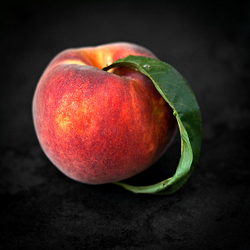 I have a great story to tell you about the peach preserves I made for this month’s CanJam — the theme of which is stone fruit — hosted by The Hip Girl’s Guide to Homemaking. But work has managed to sap every last ounce of my attention this week, and it’s already 11pm. Making matters worse, the hard-and-fast deadline for the CanJam roundup means this post must go up no later than midnight tonight. Time, it seems, is not on my side.
I have a great story to tell you about the peach preserves I made for this month’s CanJam — the theme of which is stone fruit — hosted by The Hip Girl’s Guide to Homemaking. But work has managed to sap every last ounce of my attention this week, and it’s already 11pm. Making matters worse, the hard-and-fast deadline for the CanJam roundup means this post must go up no later than midnight tonight. Time, it seems, is not on my side.
So you’ll just have to trust me when I say that the peaches we bought — the deep, aromatic, and complex-flavored ‘Oh Henry’ variety from Woodleaf Farm — were so damned perfect that we couldn’t bear to embellish them with the fancy ingredients we had originally planned to use. Instead, we turned to a formula that I learned years ago from preserves maven June Taylor, a simple recipe that lets the taste of the fruit shine.
We also wanted to preserve the deep blush of the peaches, so we didn’t peel our fruit before jamming. And truthfully, unless your peaches have problem skin, we recommend just giving them a quick rinse in cool water and drying them with a towel. Peeling is a pain in the neck, and you won’t notice the difference in the final preserve.

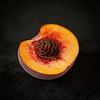
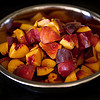
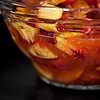
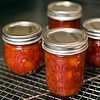
Perfectly Simple Peach Preserves
– adapted from June Taylor
 3 pounds pitted ripe peaches
3 pounds pitted ripe peaches
– rinsed, dried, and cut into bite-sized pieces
10 oz white sugar*
2-1/2 T lemon juice
1 T orange zest
4 8-oz canning jars and lids
Prepare canner, lids, and jars according to the usual method; keep jars hot until needed.
Toss together the ingredients in a non-reactive bowl and let sit, covered, overnight to allow the peaches to soften and release their juices.
Transfer the macerated fruit and juices into a heavy, wide stainless-steel pot, and bring to a boil, stirring as necessary. After the mixture comes to a boil, reduce heat to maintain a steady simmer; stir frequently to distribute the mixture and prevent burning.
Actual cooking time will vary depending on the fruit’s moisture level and the speed of your simmer. Most batches are done at between 20 and 25 minutes; you don’t want to simmer longer than 30 minutes or the sugars will begin to caramelize.
As the mixture approaches a sauce-like consistency, stir constantly to prevent scorching. To test for proper gel, use the saucer test or watch for the liquid to sheet off the edge of a metal spoon.
When the preserves have reached the proper set, remove from the heat. Working quickly, ladle into hot prepared jars, leaving 1/4-inch headspace. Remove air bubbles and adjust headspace as needed. Wipe rims and center lids on jars; screw band to fingertip-tight.
Place jars in canner, ensuring they are completely submerged. Bring to a boil and process jars for 10 minutes with the canner lid on. When time is complete, remove canner lid and turn off heat; wait 5 minutes, then remove jars. Cool, check for seals, and store in a cool, dark place for up to 6 months.
—
* Sugar can and should be adjusted depending on the fruit’s level of sweetness and your own taste. The sweetest fruit will require a ratio of 5.5 pounds of prepared fruit to 1 pound of sugar; the least-sweet fruit will be closer to 4:1.
CanJam, locavore, preserving & infusing, recipes
7 Comments »




Posted by Anita on 07.23.10 8:13 PM
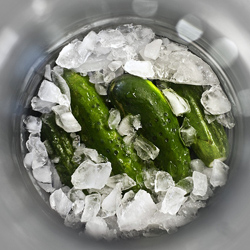 I’ve always wanted to make real kosher dill pickles, the kind that our grandparents might have bought from a barrel at their local dry-goods shop. Like sauerkraut or kimchee, these pickles get their sourness entirely from the fermentation process rather than the vinegar found in many pickle recipes.
I’ve always wanted to make real kosher dill pickles, the kind that our grandparents might have bought from a barrel at their local dry-goods shop. Like sauerkraut or kimchee, these pickles get their sourness entirely from the fermentation process rather than the vinegar found in many pickle recipes.
With the crazy spring weather we had this year, it’s still rather early here for cucumbers, but the CanJam challenge — hosted by Gloria at Laundry Etc. — waits for no woman. The biggest cukes in our garden are barely longer than my thumb, and though I’d dearly love to make cornichons, we don’t yet have enough yet to fill even a single jar.
Persian and Asian cucumbers are abundant at the Ferry Plaza market already, but search as we might, we came up empty for pickling varieties like Kirby from any farm-direct sources. After scouring our local co-op grocery and more than one Whole Foods for just-ripe, unblemished specimens, we managed to scrounge up enough suitable cukes to make a small batch of kosher-style dills.
Right from the start, they smelled amazing, giving off a heady whiff of garlic atop the earthy tang of dill. But alas, something was amiss; the brine never clouded as it should have, to indicate the all-important presence of friendly bacteria. Apparently, the fermentation process never took off at all. After two weeks, our would-be pickles were merely over-salty cucumbers, fit only for the compost pile.
Staring down the CanJam deadline, I knew I didn’t have time for a replacement fermented batch before time ran out. My usual dill pickle recipe is reliable, good, and quick — a simple cold-pack, vinegar-brined thing — but nothing special. In the spirit of stretching a little, I hit the books before heading out to hunt down yet another armload of cucumbers.
I found a compromise recipe of sorts, neither a fermentation nor a one-step pickle. My interest was piqued by method I’d never seen before: The cucumbers soak for 12 hours in a superchilled mixture of ice, water, and salt — a step that many sources say keeps the pickles crisp, even after processing in a boiling water bath. Although I’d discovered the recipe in a chapter titled “2-day Vegetable Pickles”, I realized that I could shave some much-needed time if I popped them in the icy brine before breakfast and processed the jars just before bedtime.
They may not be the fermented pickle of my dreams, but they’re pretty fabulous. The crisp spears offer a strong hit of garlic and a less-aggressive acidity than your typical homemade dills. Once our own cucumbers come in, I’m game to try another batch of the real fermented deal. But for now, I’m perfectly happy with my not-quite-kosher dills.
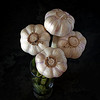
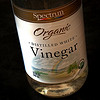
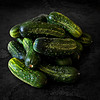
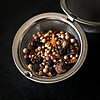
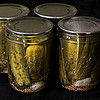
Ice-Brined Garlic Dill Pickles
– from the Ball Complete Book of Home Preserving
 8 lbs pickling cucumbers, gently washed & ends trimmed
8 lbs pickling cucumbers, gently washed & ends trimmed
16 cups crushed ice
1-1/4 cups pickling salt, divided use
12 cups water, divided use
2T pickling spice
6 cups white vinegar
1/4 cup sugar
7 tsp yellow mustard seeds
10-1/2 fresh dill heads or 7T dill seeds (we used 7 sprigs fresh dill)
7 large (or 14 small) cloves garlic
– Day 1 (or early morning)
In a large clean crock (or tall ceramic, glass, or stainless steel bowl), layer the cucumbers and the ice.
In a large glass or stainless steel bowl, dissolve 1/2 cup of the pickling salt in 4 cups of the water. Pour over the cucumbers, adding enough cold water to cover the cucumbers, as needed. Place a large, clean inverted plate on top of the cucumbers and weigh down with two or three quart jars filled with water (and capped). Refrigerate or let stand in a very cool place for at least 12 hours, but no longer than 18 hours.
– Day 2 (or late evening)
Prepare canner, lids, and 7 pint jars according to the usual method; keep jars hot until needed.
Tie pickling spice in a square of cheesecloth (or use a tea-infusing ball).
In a large stainless steel saucepan, combine remaining 8 cups water, vinegar, remaining 3/4 cup pickling salt, sugar, and spice packet. Bring to a boil over medium-high heat, stirring to dissolve sugar and salt. Reduce heat, cover, and boil gently for 15 minutes, until spices have infused the liquid.
Transfer cucumbers to a colander placed over a sink and drain. Rinse with cool running water and drain thoroughly. Place dill and a garlic clove in each jar. Pack cucumbers into jars to within a generous 1/2 inch of the rim. Add 1 tsp mustard seed to each jar.
Using a stainless-steel canning funnel, pour hot pickling liquid into hot jars, leaving 1/2-inch headspace. Wipe rims and center lids on jars. Screw band to fingertip-tight.
Place jars in canner, ensuring they are completely submerged. Bring to a boil and process covered for 10 minutes. Remove canner lid; wait 5 minutes, then remove jars. Cool, check for seals, and store in a cool, dark place for up to a year.
CanJam, preserving & infusing, recipes
11 Comments »




Posted by Anita on 06.25.10 3:08 PM
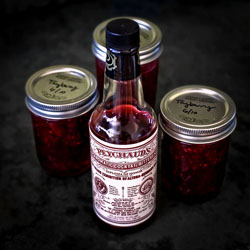 Growing up in Southern California, no summer was complete without boysenberry-flavored treats like boysenberry pie, boysenberry ice-cream topping, and even boysenberry pancake syrup. Popularized by Walter Knott at his Buena Park farmstand — years before Knott’s Berry Farm morphed into Southern California’s second-fiddle amusement park — this blackberry-raspberry hybrid boasts large fruit and a tart-yet-sweet taste that brings together the best qualities of both its parents.
Growing up in Southern California, no summer was complete without boysenberry-flavored treats like boysenberry pie, boysenberry ice-cream topping, and even boysenberry pancake syrup. Popularized by Walter Knott at his Buena Park farmstand — years before Knott’s Berry Farm morphed into Southern California’s second-fiddle amusement park — this blackberry-raspberry hybrid boasts large fruit and a tart-yet-sweet taste that brings together the best qualities of both its parents.
Sadly for us in Northern California, the boysenberries of my youth are highly perishable; they don’t travel well, and they need to be eaten or preserved within a day of being picked. I’ve only found them once locally, and their mushy texture and under-ripe flavor didn’t match up to my childhood memories. On our recent Los Angeles vacation, I nearly cried with nostalgia when I found a box of boysenberries at the Hollywood Farmers Market; I took them back to our vacation house and greedily popped them in my mouth like bonbons, knowing full well that they might be the only boysenberries I’d taste for a long, long time.
But boysenberries are just one of many varieties of blackberry-raspberry hybrids, and a number of their close cousins — including olallieberries, loganberries, and tayberries — grow well and abundantly here. Of the three, my favorite are the tayberries: large-ish berries with a heady, floral aroma that highlights their Rosaceae family ties to roses and plums. Less seed-riddled than raspberries, but more complex-tasting than domesticated blackberries, tayberries may well have stolen my heart away from the boysenberries of days past. (Absence may make the heart grow fonder, but a girl has her limits.)
Anxious to preserve some of that mysterious tayberry flavor, I decided to make them the star of our entry for this month’s Berries/Cherries CanJam, hosted by Well Preserved. Tayberries’ spicy undertones and deep ruby-red color reminded me of the bottle of Peychaud’s bitters in our home bar, and the floral notes of both ingredients mix and mingle to make one heck of a summer preserve. Our first three-jar batch was so craveworthy, I made a beeline for the berry stand the very next weekend to make a few more jars.
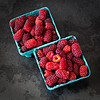

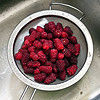
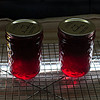

Tayberry-Peychaud Preserves
– adaped from Blue Ribbon Preserves
7 cups whole, firm tayberries
6-1/2 cups sugar
1/2 tsp unsalted butter
3oz liquid pectin
2T Peychaud’s bitters
Prepare canner, lids, and seven 8-oz jars according to the usual method; keep jars hot until needed.
Gently rinse the berries, and drain well. (If berry seeds trouble you, you may want to mash half of the berries through a sieve.) Alternately layer the berries and half the sugar in an 8-quart pan; let stand for 30 minutes.
Gradually heat the berry mixture over medium-low heat until most of the sugar is dissolved, stirring to prevent sticking. Add the remaining sugar, a cup at a time, stirring between each cup. Heat until the sugar is completely dissolved, then stir in the butter.
 Bring the mixture to a rolling boil over medium-high heat, stirring constantly. Stir in the pectin, return the mixture to the rolling boil, again stirring constantly. Boil while you stir for 1 minute. Remove the pan from the heat, and skim off any foam. Set aside for 5 minutes to help prevent floating fruit. Gently stir in the bitters and distribute the fruit.
Bring the mixture to a rolling boil over medium-high heat, stirring constantly. Stir in the pectin, return the mixture to the rolling boil, again stirring constantly. Boil while you stir for 1 minute. Remove the pan from the heat, and skim off any foam. Set aside for 5 minutes to help prevent floating fruit. Gently stir in the bitters and distribute the fruit.
Using a stainless-steel canning funnel, ladle preserves into hot jars, leaving 1/4-inch headspace. Wipe rims and center lids on jars. Screw band to fingertip-tight.
Place jars in canner, ensuring they are completely submerged. Bring to a boil and process covered for 10 minutes. Remove canner lid; wait 5 minutes, then remove jars. Cool, check for seals, and store in a cool, dark place for up to a year.
CanJam, preserving & infusing, recipes
11 Comments »




Posted by Anita on 05.26.10 11:28 AM
This post is the third of 12 installments in the Dinner on a Deadline series, a project designed to help you get thoughtful meals on the table quickly without resorting to processed convenience foods. Each week features homework to help you put the lessons into action, plus a sample recipe to show how we use the week’s tips in real life.
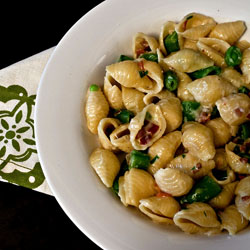 There are entire books (and at least one blog) devoted to the idea that recipes are the problem, not the solution. Rather than cheerful assistants, the theory goes, recipes can be tyrannical oppressors, stifling creativity and causing culinary heartache.
There are entire books (and at least one blog) devoted to the idea that recipes are the problem, not the solution. Rather than cheerful assistants, the theory goes, recipes can be tyrannical oppressors, stifling creativity and causing culinary heartache.
Though I’d never go that far myself — my cookbooks and recipe binders are a source of wonderful inspiration, and a great resource for those rare days when I have plenty of time to spend in the kitchen — I definitely see the value of dispensing with recipes for many everyday meals.
When it comes to no-recipes meals, there are plenty of old standbys. On Twitter, I asked what readers like to make when they cook without recipes. Nearly everyone named at least one dish that falls into the category our friends Sean and DPaul call leftovers velcro: Omelettes and frittatas filled with bits of cheese and herbs, a chef’s salad with cold roast chicken and a few crumbles of bleu cheese, hearty soups made from stock and the assorted contents of the vegetable bin.
All of these are good, simple meals, and I love them because creative re-use is both easy on the wallet and environmentally fabulous. But cooking without recipes can be much more than just a way to clear out your fridge. It’s a way of thinking about ingredients that gives you basic formulas for easy suppers, and a platform for improvising even as you plan. If you stock your pantry well, you can combine protein, starch, and seasonal vegetables in dozens of ways.
 Here’s one example that makes use of our favorite pasta + pork + greens trinity: Simmer pasta of your choice. Meanwhile, sauté sausage, bacon, ham, or ground pork; remove the cooked meat with a slotted spoon. Using the same skillet, sauté a clove or two of minced garlic in the rendered fat from the meat; add legumes or greens (examples: shredded kale, chopped broccoli raab, sliced sugar-snap peas, cooked cannellini) and sauté until tender, adding a little stock or water to steam the firmer items. When the pasta’s done, toss everything together, adding a splash of stock or cream. Sprinkle with herbs and/or Parmesan cheese and you’re good to go. (Two favorite variations on this theme include Orecchiete with Broccoli di Ciccio and Italian sausage, and Pasta e Fagioli with ‘Nduja.)
Here’s one example that makes use of our favorite pasta + pork + greens trinity: Simmer pasta of your choice. Meanwhile, sauté sausage, bacon, ham, or ground pork; remove the cooked meat with a slotted spoon. Using the same skillet, sauté a clove or two of minced garlic in the rendered fat from the meat; add legumes or greens (examples: shredded kale, chopped broccoli raab, sliced sugar-snap peas, cooked cannellini) and sauté until tender, adding a little stock or water to steam the firmer items. When the pasta’s done, toss everything together, adding a splash of stock or cream. Sprinkle with herbs and/or Parmesan cheese and you’re good to go. (Two favorite variations on this theme include Orecchiete with Broccoli di Ciccio and Italian sausage, and Pasta e Fagioli with ‘Nduja.)
This method also works great with international flavors. For an Asian-style meal, sauté a quick-marinated protein (sliced meat, shrimp, or tofu tossed with soy sauce, sherry, sesame oil, and a bit of cornstarch) in peanut oil; remove with a slotted spoon. Sauté garlic and greens (such as long beans, bok choy, spinach) until tender. Stir in a regionally appropriate flavor enhancer (like curry paste, oyster sauce, chili-garlic sauce), then add the meat back into the pan and heat through; serve over rice or noodles. If you prefer a Tex-Mex variation, you can make fajitas: Grill or sauté chicken or steak strips, add sauteed peppers and onions, and serve with tortillas. Once you have the basics down, the variations are only limited by your imagination and the depth of your pantry.
This week’s homework
No-recipe novices: Plan at least two meals for the upcoming week, including at least one no-recipe dinner. Make use of your newly organized pantry staples.
Extra for experts: Take one of your existing no-recipe meals and adapt it into something new. For example: If you usually use pasta as the base, turn it into a stir-fry over rice. Or, add an ethnic twist, use a different protein, or make some other modification that will push your creativity.
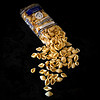

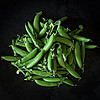
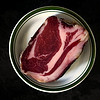
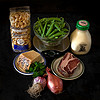
This week’s recipe
I realize that this goes entirely against the spirit of the lesson, giving you a real recipe with measurements and timing. But for anyone new to the no-recipes concept, it’s useful to see how it works. After you’ve done it a few times, you’ll be able to come up with your own variations, judging quantities and timing by eye.
We made this dish — a Food 52 category winner — for a midweek supper with our friend Meriko; we liked it so much we had it again this week. (The fact that we’ve got a bumper crop of sugar-snap peas helps, too.) The second time around, we were out of mint and low on cream, so we swapped in some parsley and chicken stock; we liked the fresher end result even better. Feel free to make your own substitutions depending on what you have on hand or what strikes your fancy.
Creamy Pasta with Prosciutto and Snap Peas
– adapted from Food 52
For each 3 servings; multiply as needed
6 to 8oz dry shaped pasta (preferrably shells, orechiette, or other cup-shaped pasta)
2 cloves garlic, minced
1-1/2 T olive oil
2oz prosciutto, lonza, or country ham, thickly sliced (1/4-inch minimum) then minced
2 small shallots, minced
1/2 cup cream
1/2 cup unsalted stock
1/4 cup freshly grated Parmesan, plus more for the table
1/4 pound fresh sugar-snap peas, chopped into 1/2-inch pieces
2T to 1/4 cup minced fresh flat-leaf parsley
salt and freshly ground pepper
In a large saucepan, bring salted pasta water to a boil while prepping the various ingredients. (If it comes to a boil before you’re ready, cover and reduce heat to low.) When everything is ready to go, add the pasta to the boiling water.
In a heavy skillet, heat the olive oil over medium heat. When shimmering, add the garlic and cook until just softened. Add the minced prosciutto and cook for an additional 3 to 4 minutes. Add the shallots; continue cooking until softened. If at any point the garlic or shallots start to brown, add a splash of water and/or turn down the heat. When cooked through, season to taste with salt and freshly ground black pepper. (Amounts will vary greatly depending on how salty your pork is.) If there are more than 3 minutes left on the pasta timer, reduce the skillet heat to low, or remove the pan from heat, depending on how long you have left.
When your pasta is about 3 minutes away from being done, add the peas to the proscuitto mixture and cook for 2 minutes over medium heat, until just tender. With one minute remaining, raise the heat to high; add the cream and stock, and bring to a boil while stirring. Add the Parmesan, stir to combine, and reduce the heat to low.
Drain the pasta, and add to the sauce; toss to coat. If the sauce is loose, simmer over medium-high heat until it coats the pasta. Sprinkle liberally with fresh herbs, and serve with black pepper and extra Parmesan.
cooking, Dinner on a Deadline, recipes
15 Comments »




Posted by Anita on 05.18.10 11:54 AM
This post is the second of 12 installments in the Dinner on a Deadline series, a project designed to help you get thoughtful meals on the table quickly without resorting to processed convenience foods. Each week features homework to help you put the lessons into action, plus a sample recipe to show how we use the week’s tips in real life.
 So, gang — how’s the menu planning going? From my point of view, the homework looks great! Between the comments on last week’s post and the Twitter stream, I’ve seen some good menu plans, lots of delicious meals made from items already on hand, and many good tips for weeknight dinner prep. So let’s move on with some more ideas for getting food on the table.
So, gang — how’s the menu planning going? From my point of view, the homework looks great! Between the comments on last week’s post and the Twitter stream, I’ve seen some good menu plans, lots of delicious meals made from items already on hand, and many good tips for weeknight dinner prep. So let’s move on with some more ideas for getting food on the table.
One of the most powerful weapons in the weeknight-dinner arsenal is a well-stocked pantry. Now, when I say “pantry”, I hear all the small-kitchen cooks groan. But a pantry doesn’t have to be large or lavish to be effective — even a single, dedicated shelf next to the dishes is better than nothing. No matter whether you have an enormous pantry or a tiny one, keeping staples on hand encourages spontaneous meals and lets you shift gears quickly when your weeknight throws you a curve. And, stocking up is especially important if you’re not a particularly dedicated meal planner.
Once you stock your pantry, keeping it up to date needs to be a continuous process. At our house, we opt for the instant-replacement method: If we use, say, a package of penne, we add penne to the grocery list and buy it on our very next trip to the store. When we get down to the last few ounces of soy sauce, it goes on the list, too. We never wait until we need a staple item to replace it. In the case of items we use a lot, we even keep backups on hand when space permits.
Speaking of space: The elephant in the room here is that most people’s pantries (including mine, until I tidied it up last weekend) look like a disaster area. Once you clear away the clutter, you may find yourself with a lot more storage space than you thought you had. With this in mind, the first real step in stocking the pantry is a thorough clean-up. I know the idea of spending your precious kitchen time tackling a long-postponed chore isn’t terribly appealing, but the payoff is huge. Even the most rudimentary kitchen organization helps make it fun to cook, instead of a hassle. Once you’ve got your kit organized, you won’t have to dig through a mess to find things when you need them quickly. You’ll also have a better idea of what you have, and what you’re missing.
When it comes to quick weeknight dinners, staples are key. There are a few million articles online dedicated to stocking your pantry. (Simple Bites has a good one, with links to many others.) Every site’s list is a little different — and they should be. There’s no one right way to fill your shelves; the important thing is that you figure out the kinds of meals you eat (or want to eat) and stock for them. Personally, I don’t like to rely a lot on the canned soups, commercially frozen vegetables, and other industrial products that some of the lists include. You know your own tastes better than I do; look through a few lists, and use them as a jumping off point.
Here’s what our pantry typically contains:
• In the fridge: Eggs, cheese (something melty plus a hard cheese like Parmesan), bacon, milk, sour cream, kimchi and/or sauerkraut, tortillas, bread, butter, mushrooms, olives, mustard, peanut & almond butters, maple syrup
•Â In the garden: Fresh herbs, lettuce, carrots, radishes, celery, lemons, green onions, one or two seasonal vegetables (peas, tomatoes, etc.)
• In the cupboard: Pastas, rices, polenta, dry beans, posole, coconut milk, chiles (pickled/dry), tomatoes, pressure-canned chicken stock, pickles & preserves, soy sauce & fish sauce, canned tuna, shallots & onions, garlic, ginger, potatoes, crackers, tortilla chips, nuts, salsas, herbs & spices, oils & vinegars, baking supplies
• In the freezer: Precooked beans and grains; pie and pizza doughs; pasta sauces; curry pastes; leftover bread/buns; leftover cooked meat; precooked meatballs; quick-thawing raw proteins (ham cubes, chicken parts, sirloin tips, ground meat, duck confit) in meal-size packs; sausages (Italian, chorizo, breakfast, ‘nduja); pancetta & guanciale; butter; blanched garden veggies; ice cubes of many types: chicken stock, lemon and lime juice, egg whites, tomato sauce/paste, chipotle en adobo, etc.
(I know there’s a a lot of untapped detail in that last bullet item; we’ll talk more about stocking the freezer later in the series.)
Looking at our list, you can probably already see that, even without a recipe, I can get a number of basic dinners on the table using just what we have on hand. This week, I made a simple Asian-style noodle dish using beef from the freezer and a bunch of items from the pantry, plus a few vegetables from our farm box. Pretty much once a week — and more often when we’ve been traveling or otherwise unable to get to the farmers market — we eat this way, “shopping” from the items we’ve put aside for quick weeknight meals.
Once you have a well-stocked larder, you’ll be amazed at how handily you’re able to put together meals, even when you’ve got “nothing” in the house. After just a few weeks of building meals from what you’ve got on hand, you’ll start to develop a repertoire of pantry-based suppers.
 In addition to this week’s recipe below, here are a few meals we make using pantry staples and just one or two fresh ingredients:
In addition to this week’s recipe below, here are a few meals we make using pantry staples and just one or two fresh ingredients:
– Simple chilaquiles
– Fondue mac & cheese
– Weeknight paella
– Korean-style tacos
– Deep-dish pizza
– Pasta carbonara
– Pea and proscuitto risotto
– Pasta with leafy broccoli and sausage
– Sopa Azteca (tortilla soup)
– Ham, chickpea, and orzo salad
– Chorizo, potato, and mushroom tacos
That’s not an exhaustive list, by the way — that’s just the pantry-centric ideas we’ve already blogged about. Once you’ve got your own pantry stocked, you’ll see the possibilities and patterns in your own meals.
This week’s homework
Novice pantry-stockers: Organize your pantry space: Take everything out and put it on the counters, wipe down the shelves, and then put things back in an order than makes sense based on the way you use them. Same thing with the fridge and the freezer — they’re an extension of your pantry, after all. Give away (to the food bank / coworkers / freecycle) anything you don’t want to eat that’s taking up space. Think about the kinds of meals you like to eat, make a list of what’s missing, and stock up as your budget permits. Plan and cook at least two meals, each using a pantry ingredient you already have.
Extra for experts: Tackle the organization project above, plus one of these two options: (1) Write a post about at least 5 items in your pantry, and why they’ve earned a permanent spot on your shelves. (2) Buy yourself one splurge-worthy ingredient (Calabrian chiles, a new kind of rice, heirloom beans, etc.) and cook with it, using at least two existing pantry ingredients that you’ve let languish.
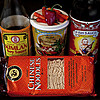
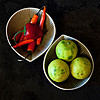
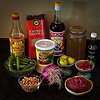
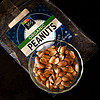
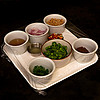
This week’s recipe
I love this recipe — which really is more like a template — because it’s so flexible. Don’t have beef? Use the same quantity of sliced chicken, butterflied shrimp, ground pork, or tofu cubes. You can use pretty much any Asian noodle, too: Fresh, dry, egg, wheat, rice, curly, straight — they all work, so long as you’ve got close to the right quantity going into the wok. Any crunchy vegetables can take the place of the peas; we’ve used boy choy pieces, green beans, and celery cut on the bias; don’t be afraid to experiment.
When it comes to Thai-style curry paste; we like the Mae Ploy brand that comes in a plastic tub (it keeps almost forever in the freezer if you roll up the inside bag tightly); this recipe is especially good with the red and yellow varieties, but it’s flexible enough to use what you’ve got. Heat and saltiness vary widely, though, so if you’re using another brand, start out with less paste; if you find the end result is a little bland, spike it up with some fish sauce and/or chile flakes at the table, and make a note to adjust the recipe the next time. I like to mix it up by using half red curry paste and half peanut butter, which makes an especially tasty combination for little kids or other spice-phobic eaters.
This recipe can be made by one focused cook in less than 30 minutes from start to finish, but to streamline the post-work chaos, I generally do all of the prep the night before, then store all of the measured and cut ingredients in the fridge overnight.
Thai Curry Beef Noodles
– adapted from Big Bowl Noodles and Rice
For two servings — multiply as needed:
4 to 6 oz dry Asian wheat or egg noodles (for substitutions, see end of instructions)
Peanut or vegetable oil
6 oz beef (such as flank steak or sirloin tip) sliced thin across the grain into 2-inch lengths
1-1/2 tsp dark soy sauce (we like Kimlan Super Special)
1 tsp sesame oil
1 tsp cornstarch
1/3 cup homemade chicken stock (or water — canned broth is too salty)
1-2T fish sauce (depending on the saltiness of the curry paste)
1T fresh lime juice
1-1/2 tsp sugar
1/2 to 1 red chile (such as Fresno), julienned
1/4 cup thinly sliced red onion
a handful (12 to 15) snow or snap peas, cut in half on the diagonal
1 to 2T Thai curry paste (depending on how hot you like it; you can use half peanut butter)
1/4 cup peanuts, chopped
a few tablespoons chopped cilantro leaves
Bring 4 to 6 quarts of water to a boil and cook the noodles according to package directions. Drain, run under cold water, drain again, and toss with a teaspoon of peanut oil; set aside.
Mix the beef with the soy sauce, cornstarch, and sesame oil. In a separate bowl, mix the chicken stock with the fish sauce, lime juice, and sugar and whisk to blend. Set both the mixtures aside.
Heat 1/2 cup oil in a wok (or your largest skillet) over high heat until very hot but not smoking; add the beef, stirring to separate the slices. Using a slotted spoon or a spider, remove the meat to a clean plate when still pink in the center. Pour off the oil into a heatproof bowl.
Wipe the wok clean and return it to the burner over high heat. When hot, add 2T of the reserved oil. Add the chiles, onions, and peas; cook, tossing rapidly, until well coated with the oil. Scoot the vegetables to the side of the wok and add the curry paste to the bottom. Stir the paste around briefly in the oil to release the flavor. Add the seasoned stock mixture; bring to a boil, stirring or whisking to distribute the curry paste. Then, add the noodles.
Cook, tossing the noodles until mixed with the sauce and vegetables. Add the beef and toss briefly until everything is heated through and well mixed. Remove the cooked noodles to a platter, sprinkle with peanuts and chopped cilantro, and serve.
—
If you want to substitute other noodles, keep in mind that fresh noodles gain very little mass when cooked, where dry pastas can double or triple in size. You want 8 to 10 oz of cooked noodles for two servings. If you find you’ve prepped too many noodles, they keep for a day or two in the fridge, provided they’re tossed liberally in oil and well covered. They make a great snack or lunch when reheated with a little peanut butter, a splash of water or stock, and a sprinkling of chili flakes.
cooking, Dinner on a Deadline, recipes
17 Comments »




Posted by Anita on 05.07.10 6:55 AM
This post is the first of 12 installments in the Dinner on a Deadline series, a project designed to help you get thoughtful meals on the table quickly without resorting to processed convenience foods. Each week features homework to help you put the lessons into action, plus a sample recipe to show how we use the week’s tips in real life.
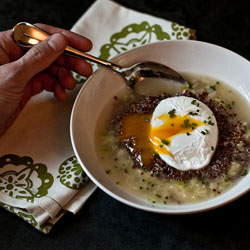
Chances are, if you’re reading this blog, you like to cook. But there’s some evil alchemy that happens on a weeknight, after a long day of work; even avid cooks lose their mojo when dinner starts to feel like drudgery. Although I’m not a planner by nature (really, I swear — stop snickering!), I’ve developed a routine that helps me fend off kitchen ennui. By mapping out our weeknight meals in advance, and making sure I have everything I need to keep things moving, I feel less harried and enjoy cooking more.
In the same way that it’s always easier to cook when you’ve done your mise en place first, it’s always easier to tackle menu planning when you’ve done a little legwork in advance. During the week, make a file of recipes that catch your eye as you’re reading magazines, blogs, and cookbooks. Then, figure out a way to get yourself at least a half an hour when you won’t be interrupted, so you can focus on your task. Clear off your desk or the table, then sit down with your calendar and your cookbooks, magazine clippings, and bookmarks. At our house, I work on menu planning on Fridays, the night before our favorite farmers market. To free up my time, Cameron fixes a garden salad and his choice of pasta — using pantry staples and homemade sauces from the freezer — while I plan dinners for the coming week.
To make menu planning less daunting, I have a few stock meals slotted into in the schedule. In addition to our regular Friday pasta night, on Tuesdays — when Cameron has band rehearsal — we usually reheat something from the freezer, like sloppy joes, chili, or a hearty soup. Plugging those standbys into my schedule, I have 2/7 of the week taken care of, right off the bat. Next, I block off any nights where we won’t need to cook: Wednesdays are rough days for us, so we often treat ourselves by going out for dinner or grabbing takeout sushi on the way home. We also frequently have some sort of outing during the week — theater tickets, dinner parties, and the like — so I note those, too. Saturdays we typically have plenty of time to spend in the kitchen, so I schedule the most time-consuming meal there, along with any kitchen projects like making big batches of chicken stock, pasta sauces, and other freezer staples. By this point, the week’s filling up nicely, and it’s just a matter of shuffling a mix of old favorites, new ideas, and seasonal inspirations from my clipping file into the remaining days.
It also helps to know what foods are in season in your area, both to minimize shopping hassles, and to keep your budget under control. Many farmers markets feature seasonality calendars on their sites (and yes, there’s an app for that). If you’re worried that your plan includes items that won’t be available, hedge your bets and know what your fallback recipe requires. If I’m planning, say, a fennel salad during a time when I don’t know whether there will be fennel at the market, I’ll make a note on the list of an alternative ingredient (like frisée) that I’m positive I can find.
If this seems like too much work, you can just head to the farmers market or grocery store and buy what looks good, but you’ll want to make sure to browse with a plan in mind. A lot of my friends do this, shopping with a list of categories like “vegetables for 2 dinners, fruit for 4 lunches” rather than an entire menu plan, then deciding when they get home how it all goes together. (I will confess that whenever I shop this way, I inevitably end up missing some key ingredient; I think my friends are better organized than I am!) If you’re not already adept at building meals from the pantry and cooking without recipes, though, you could find yourself with too much of one sort of thing, like tempting-but-perishable vegetables, and not enough of something critical, like meats or starches.

Speaking of surpluses: Meal planning can help prevent food waste and the motivation-sapping guilt that goes with it. I start my planning with a quick fridge inventory. With a list of what’s in the crisper, I can plan the next week’s meals to use up stragglers before they turn to compost.
As funny as it sounds, one of my menu planning secrets is to leave room for a little spontaneity. I always keep at least one night open, allowing us to accept impromptu dinner invitations, indulge a craving, or polish off leftovers.
Just as every cook has a different style, your planning will be different than mine. There’s a universe of software, sites, even iPhone apps designed to help you plan meals; the good ones will create a shopping list automatically as you add recipes to the menu. I find that a little too complicated for my taste; my system involves nothing more than a word-processing document in GoogleDocs with a shopping list down one side and menus down the other. I keep it online so both of us can reference it from anywhere — home, work, the grocery store — in case we need to add to it or shop from it. It doesn’t really matter what system you use, but it needs to work for you.
Have I scared you off yet? If the thought of planning for the whole week seems overwhelming, start with just a couple of planned meals and see how it goes. I think if you plan at least a few meals every week, you’ll begin to see how much easier it is to get dinner on the table without a lot of drama. The more you plan, the less likely you are to push the panic button and find yourself dialing for pizza.
This week’s homework
Novice planners: Plan out at least 2 meals for the coming week. Make a shopping list for your planned meals. Print out the recipes you’ll be using (or flag them in books) so you can find them easily when you hit the kitchen. If the meal you’re planning takes more than 30 minutes of prep, see if you can figure out a way to break it into manageable chunks by prepping parts of the recipe in advance the night before or the morning of.
Extra for experts: If you’re already planning meals ahead of time, this one’s for you: Make at least one full meal this week from what you already have on hand in your fridge, freezer, or pantry, without shopping for anything new. Bonus points for dessert.
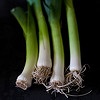



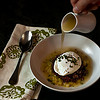
This week’s recipe
When my friend Jen and I went to dinner recently at Range, I ordered an appetizer that epitomized spring comfort foods for me. I’m a sucker for anything with an egg on top; the buttery leeks were indulgent, and the Parmesan broth was silky and rich. Looking at the various components, I had a hunch that I could re-create this combination at home.
As I started planning this meal, I was excited to realize I could make it entirely from things I already had on hand, although you certainly could buy them from any good grocery store. (Quinoa, by the way, can often be found in the bulk bins; feel free to substitute brown rice, lentils, or any other small, quick-cooking grain or legume.) With a little reheating and a quick bit of actual cooking, our dinner — a credible duplicate of a dish served at a Michelin-starred restaurant — was on the table in less than 20 minutes.
In the coming weeks, I’ll talk more about stocking your larder so that you can improvise, too. In the meantime, you should be able to make all the components from start to finish in less than an hour, even quicker if you’ve got a helper. If you’d rather do some of the prep work in advance — a topic we’ll discuss in more depth later in the series — I’ve noted how far out you can make that happen. Add a simple salad and a glass of wine, and you’ve got a meal that you’d be proud to serve to anyone.
Melted Leeks and Quinoa with a Poached Farm Egg and Parmesan Broth
– inspired by a first course at Range
For each serving — multiply as needed:
1/3 cup melted leeks
1/2 cup cooked quinoa
1/2 cup simmering chicken stock
a handful of Parmesan cheese, grated as finely as possible (about 1/2oz by weight)
1 extra-large egg
minced chives, for garnish
salt, as needed
Up to a week in advance:
– Make the melted leeks
- Slice the leeks in half lengthwise, then slice the white and light-green parts into half-rings about 1/4- to 1/8-inch thick. Rinse leek slices well in a bowl of running water. Melt butter in heavy skillet over medium-low heat. Add leeks and a couple of tablespoons of water. Simmer slowly until leeks are tender and almost all water evaporates, adding more water if needed to further soften the leeks. Season well with salt. If using immediately, remove pan from the heat and set aside. Otherwise, cool to room temperature and store for up to a week in the fridge. (2 cups sliced raw leeks + 4T butter makes about 2/3 cup cooked, enough for 2 servings.)
Up to 24 hours in advance:
- Thaw the stock in the fridge, if frozen.
- Grate the Parmesan cheese with your finest grater, and refrigerate. (We use a Microplane zester so the cheese melts almost instantly when it hits the broth.)
When you’re ready for dinner:
- Cook the quinoa. (1.5x water to 1x quinoa, slow-simmered about 20 minutes or until all water evaporates. 1/2 cup quinoa + 3/4 cup water makes 1-1/4 cups cooked, a little more than enough for 2 servings.)Â
- Warm the leeks in a skillet with just a splash of added water.
- Mince the chives.
- Bring the chicken broth to a lively simmer and whisk in the Parmesan.
- Just before you’re ready to serve, soft-poach the eggs.
- While the eggs are cooking, divide the melted leeks among individual bowls, spreading to cover about 2/3 of the bottom of the bowl. Scoop the quinoa over the leeks, and top each serving with a soft-poached egg. Sprinkle with chives, and pour the Parmesan broth around the edges of the bowl.
Plan-ahead ideas that made this meal easier:
– Having chives in the windowbox
– Stocking interesting stuff in our larder (quinoa, Parmesan, farm eggs, homemade stock)
– Breaking prep tasks across multiple days (pre-cooking leeks, pre-grating cheese, etc.)
Melted Leeks and Quinoa with a Poached Farm Egg and Parmesan Broth
– inspired by a first course at Range
For each serving — multiply as needed:
1/3 cup melted leeks
1/2 cup cooked quinoa
1/2 cup simmering chicken stock
a handful of Parmesan, grated as finely as possible (about 1/2oz by weight)
1 extra-large egg
minced chives, for garnish
salt, as needed
Up to a week in advance:
- Make the melted leeks
Slice the leeks in half lengthwise, then slice the white and light-green parts into half-rings about 1/4- to 1/8-inch thick. Rinse leek slices well in a bowl of running water. [LM: you can also rinse the leeks after slicing in half lengthwise and before slicing. It’s easier to do than rinsing the slices if you leave them connected at the top. Then you can just shake off before slicing] [AC: I agree with JenH; I’ve tried it both ways. Plus, the extra water isn’t an issue here.] Melt butter in heavy skillet over medium-low heat. Add leeks and a couple of tablespoons of water. Simmer slowly until leeks are tender and almost all water evaporates, adding more water if needed to further soften the leeks. Season well with salt. If using immediately, remove pan from the heat and set aside. Otherwise, cool to room temperature and store for up to a week in the fridge. (2 cups sliced raw leeks + 4T butter makes about 2/3 cup cooked, enough for 2 servings.)
Up to 24 hours in advance:
- Thaw the stock in the fridge, if frozen.
- Grate the Parmesan cheese with your finest grater, and refrigerate. (We use a Microplane, so it melts almost instantly.) [ST: Do you really? Does it not affect the texture and flavor too much to grate it that far in advance?] [AC: I don’t grate the whole wedge, but if I’m using it within the day I don’t notice a difference.]
When you’re ready for dinner:
- Cook the quinoa. (1.5x water to 1x quinoa, slow-simmered about 20 minutes or until all water evaporates. 1/2 cup quinoa + 3/4 cup water makes 1-1/4 cups cooked, a little more than enough for 2 servings.) [ST: This is something I might put in the make-ahead category. If I’m making any kind of grain, I make more than I need, and use it over a few meals. Quinoa holds up well.][AC: I actually find premade quinoa to be gluier than I like, but I’d love it if you could add your experience in the comments once the post goes up.]
- Warm the leeks in a skillet with just a splash of added water.
- Mince the chives.
- Bring the chicken broth to a lively simmer and whisk in the Parmesan.
- Just before you’re ready to serve, soft-poach the eggs.
- While the eggs are cooking, divide the melted leeks among individual bowls, spreading to cover about 2/3 of the bottom of the bowl. Scoop the quinoa over the leeks, and top each serving with a soft-poached egg. Sprinkle with chives, and pour the Parmesan broth around the edges of the bowl.
Plan-ahead ideas that made this meal easier:
– Having chives in the windowbox
– Stocking interesting stuff in our larder (quinoa, Parmesan cheese, farm eggs, homemade stock)
– Breaking prep tasks across multiple days (pre-cooking the melted leeks, pre-grating the cheese, etc.)
cooking, Dinner on a Deadline, meatless, recipes
29 Comments »




 Rhubarb when raw is so tough
Rhubarb when raw is so tough La Paloma Rosada
La Paloma Rosada

































 3 pounds pitted ripe peaches
3 pounds pitted ripe peaches































